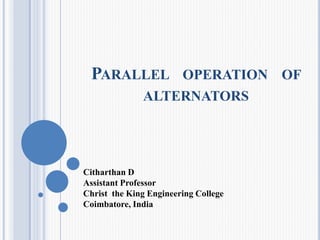Parallel operation of alternators 1
•Als PPTX, PDF herunterladen•
9 gefällt mir•5,197 views
Melden
Teilen
Melden
Teilen

Empfohlen
Empfohlen
Weitere ähnliche Inhalte
Was ist angesagt?
Was ist angesagt? (20)
Lec # 07 parallel operation of synchronous generators

Lec # 07 parallel operation of synchronous generators
Armature reaction and parallel operation of a Syncronous generator

Armature reaction and parallel operation of a Syncronous generator
EMF EQUATION OF DC GENERATOR,DC MOTOR|DAY15|BACK EMF,TORQUE OF DC MOTOR|BASIC...

EMF EQUATION OF DC GENERATOR,DC MOTOR|DAY15|BACK EMF,TORQUE OF DC MOTOR|BASIC...
Speed control of dc motor conventional methods and solid state control

Speed control of dc motor conventional methods and solid state control
Ähnlich wie Parallel operation of alternators 1
Ähnlich wie Parallel operation of alternators 1 (20)
Sizing generators-for-leading-power-factor white-paper-24_feb14

Sizing generators-for-leading-power-factor white-paper-24_feb14
Presentation on Transformer,it's working principle

Presentation on Transformer,it's working principle
Mehr von Citharthan Durairaj
Mehr von Citharthan Durairaj (16)
Equivalent Circuit, Phasor Diagram, Power Factor Control , V & Inverted V Cur...

Equivalent Circuit, Phasor Diagram, Power Factor Control , V & Inverted V Cur...
Closed Loop I-F control using six step current source inverter

Closed Loop I-F control using six step current source inverter
Voltage Source Inverter VSI - Pulse Width Modulation (PWM)

Voltage Source Inverter VSI - Pulse Width Modulation (PWM)
V/F control of Induction Motor - Variable voltage and Variable frequency

V/F control of Induction Motor - Variable voltage and Variable frequency
Torque speed characteristics of Squirrel cage & Slip ring induction motors

Torque speed characteristics of Squirrel cage & Slip ring induction motors
Steps to be done in blynk app to get alert notification or email

Steps to be done in blynk app to get alert notification or email
Parallel operation of alternators 1
- 1. PARALLEL OPERATION OF ALTERNATORS Citharthan D Assistant Professor Christ the King Engineering College Coimbatore, India
- 2. If we need to operate the alternator in parallel we need to synchronize the alternators. Condition for synchronizing: The source (generator or sub-network) must have equal 1. line voltage 2. Frequency 3. Phase sequence 4. Phase angle 5. Waveform to that of the system to which it is being synchronized. Waveform and phase sequence are fixed by the construction of the generator and its connections to the system. So the voltage, frequency and phase angle must be controlled each time a generator is to be connected to a grid.
- 3. A1 A2 ZS ZS Local circuit Consider alternator A1 produces an e.m.f E1 whereas alternator A2 produces an e.m.f E2. With respect to the load, their e.m.fs are normally in phase: with respect to the local circuit their e.m.fs are in phase-opposition as shown in below fig. E1 E2 So there will not be any circulating current ( since resultant e.m.f is zero) E1 E2 Circulating current (Ic) = Er/2Zs Analysis of Synchronized Alternators A1 and A2 on no load
- 4. Let us consider two abnormal conditions on no-load 1)Change in prime mover 2)Change in Excitation
- 5. Suppose there to be no external load if machine 2 for some reason accelerates (by its prime mover), its e.m.f. will draw ahead of machine 1. Consider the resulting Phase difference is 2∂. E1 2∂ E2Er 1) Change in Prime mover input (On no Load)
- 6. When Zs = Resistance Circulating current (Ic) will be in phase with the resultant EMF (Er) E1 2∂ E2Er Ic (circulating current) almost Quadrature to E1 and E2)
- 7. When Zs= inductive Circulating current (Ic) will lags the resultant EMF (Er) E1 2∂ E2Er Ic almost in phase with E2 }Synchronizing power This synchronizing power makes the alternator A2 to work as generator and A1 as motor. i.e alternator A2 supplies current to alternator A1
- 8. Since alternator A2 supplies current it gradually lags whereas alternator A1 acting as a motor gradually leads. E1 2∂ E2 E2 ∂ E1 (During Transition) (At steady state condition Er= 0 , Hence no circulating current )
- 9. Thus the presence of more resistance in the generators will resist or oppose their synchronous operation. More reactance in the generators can cause good reaction between the two and help the generators to remain synchronism in spite of any disturbance occurring in any one of the generators. From phasor diagram , total synchronizing power, Maximum synchronizing power and synchronizing torque can be calculated
- 10. 2) Change in Excitation (on no load) With respect to the load, their e.m.fs are normally in phase: with respect to the local circuit their e.m.fs are in phase-opposition as shown below. A1 A2 ZS Local circuit E2 Circulating current (Ic) = Er/2Zs E1 E2 I1 I2
- 11. If excitation of alternator 1 is increased then magnitude of E1 will be more than that of E2 E2 E1 Er Isy (circulating current) Isy - lagging current for E1 which will produce demagnetizing effect and will try to reduce the emf E1. Isy - leading current for E2 which will produce Magnetising effect and will try to increase the emf E2. Hence circulating current will try to make the two generated emf equal at no load.
- 12. Hence cos φ1 (phase 1) is reduced and cos φ2 (phase 2) is increased. Thus changes in KW loading of the two alternator is negligible but reactive power KVAR1 from the alternator is increased whereas KVAR2 supplied by second alternator is decreased which can seen from power triangle.
- 13. THANKS